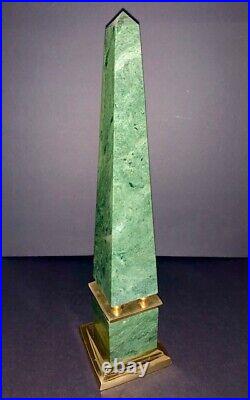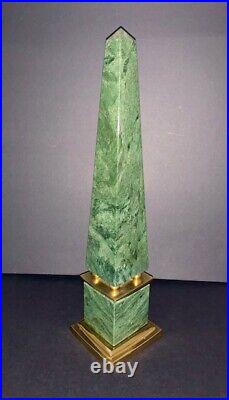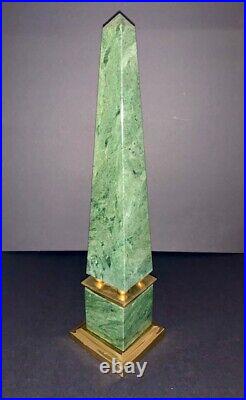Vtg Mid Century 60s Art Deco Style Hollywood Regency Green Marble Brass Obelisk






Vtg Mid Century 60s Art Deco Style Hollywood Regency Green Marble Brass Obelisk. This is a stunning Art Deco style Hollywood Regency piece from the 1960's! A solid brass base supports the solid green marble obelisk. The obelisk is separated by another smaller brass platform with 4 brass balls and then continues to a tapered point.
The marble has a lacquered finish to keep its shine and lustre. It is not recommended this be polished. This was well cared for in a smoke free home.
No breaks, cracks, chips or repairs. May have light wear and patina due to age and pre-owned display. May need a light dusting due to display and storage. To care for lacquered marble, you can.
Use a soft, slightly damp cloth to dust and clean the marble. You can also use lukewarm water and gentle soap. Polishing can damage and cloud the lacquer. The obelisk is a tapered monolithic pillar, originally erected in pairs at the entrances of ancient Egyptian temples. Carved from a single piece of stone, typically red granite from the quarries at Aswan, obelisks symbolized the stability and creative force of Atum, the Sun God Ra.
Placed in pairs at temple entrances and Old Kingdom tombs, they were closely associated with the cult of Ra and believed to provide magical protection to monuments like temples and tombs. The obelisk represented the sun god Ra and, during the religious reformation of Akhenaten, was considered a petrified ray of the Aten, the sundisk. Ancient Romans were greatly influenced by the obelisk form, leading to more obelisks standing in Rome than remaining in Egypt. Obelisks were significant monuments made of stone and placed in public spaces. Pharaohs commissioned these grand structures to ensure their lasting remembrance. Check out our other listings!